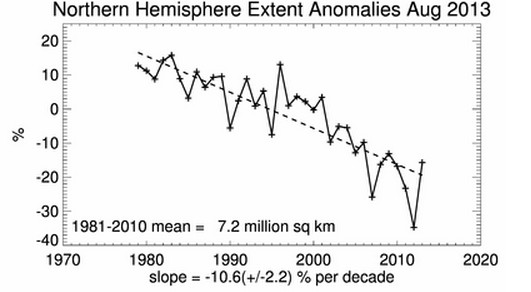http://stevengoddard.wordpress.com/2013/09/09/the-long-term-trend-towards-scientific-stupidity/
A day or so after I published my take on the daily mails very flawed (and that is being generous) article, the guardian did an even better job and can be viewed here:
http://www.theguardian.com/environment/climate-consensus-97-per-cent/2013/sep/09/climate-change-arctic-sea-ice-delusions
Steven has attempted to post his own rebuttal to this article. In fact very little of the entire thing was brought up, S only chose to 'debunk' a few points.
Alarmists like Nuttercelli are hiding behind what they call “the long term trend” in Arctic ice, as a way to avoid a serious discussion about the 60% increase in ice this year.Actually the article did acknowledge the truth of the 60% increase as can be seen in the following quotation:
While this factoid is technically true, it's also largely irrelevant.The article makes a point of backing up this claim of irrelevance and that is the whole point of the article. I am not however above the very basic technical fact checking. What is your source of the 60% increase steven? Different algorithms spit out different figures, if you provide no source then it makes it all the more difficult to verify. I gave the daily mail the benefit of the doubt and used the NSDIC August figure, but I am getting tired of having to do this.
The first thing to note is that NSIDC starts their graph at the century maximum in 1979. In the early 1970s, sea ice was much less extensive than later in the decade. If NSIDC included the entire satellite record in their graph, it would look like a sine wave, not a straight line.
The claim that 1979 is the centuary maximun is extremely dubious. I cannot find a reliable source that can confirm this claim. Steven links back to an early IPCC report, and a sea ice NH extent diagram that only goes back to circa 1972. Indeed 1979 does seem to be at a maximun, although a close inspection shows that this is only true for the winter period, and indeed subsequent years have probably higher maxima in August according to the diagram. The NSDIC also produced a long term chart which I have copied in below (hopefully this should address Stevens final sentence).

(source: http://nsidc.org/icelights/2011/01/31/arctic-sea-ice-before-satellites/)
appearing to also contradict the claim that 1979 was a century maximum (if this is still not enough here is a further source that appears to disagree with stevens claim: http://onlinelibrary.wiley.com/doi/10.1029/2007GL032507/) Even if it was a century maximun (citation still needed), there is a legitimate reason for it being the first point on the graph; that is when the reliable satellite record began so is certainly not arbitrary in stark contrast to taking 1998 as a start year in the global temperature record, a very strong el nino year.
Another important issue is that plotting linear trends on short sections of a cyclical function – is junk science and mathematics. Even if August ice was at an all-time record high, the post-1979 linear trend would still be down, as shown in the demonstration purposes only graph below.I think you might have misunderstood Anthony Watt here Steven. I don't mean to be insulting for no reason but you are confusing your mistake here:
http://wattsupwiththat.com/2010/07/02/arctic-ice-increasing-by-50000-km2-per-year/

with an appropriate place to take a linear trend line. Firstly August monthly sea ice extent averages plotted yearly are not cyclical in the same way that plotting daily sea ice extent are. In the later case there is a well defined period (a year), and amplitude (although it may vary) can quite easily be defined also. Now compare to the graph from the nsdic you are trying to debunk:

No easily defined period, or amplitude. And it certainty does not look like a sine wave. There may be natural 'cycles' hidden in there to some degree, but that is certainly a conclusion that cannot come from looking at this graph alone, and if it is being used as a premise then, again, it should be sourced appropriately.
This quote from Anthony watts (on your article) seems strangely appropriate:
This is always a problem with graphing any cyclical trend, but the short length of the record (8 years) makes it more problematic than what would be seen in a 30 year record.But whatever way you look at it Steven, the summer sea ice NH trend is still down (as it is incidentally in other months too). You are actually correct that introducing an anachronistic 2013 point above 1979 would not change the overall trend, if this had happened it would be an anomaly and it certainly would raise a few eyebrows. However the only way the long term trend is going to stop pointing down, is several years that continuously make it above the current trend. Otherwise such an anomaly is as meaningless as 2013 being above 2012 as the guardian article pointed out.
The 60% wasn't even true, Bob Ward from the Grantham Research Institute on Climate Change and the Environment states;
ReplyDelete"the NSIDC confirmed to me yesterday that the main figure used by Rose for his article was mistyped and that the mistake was corrected on 10 September, showing that Arctic sea extent in August 2013 was only 29 per cent higher than was recorded for the same month last year."
http://www.lse.ac.uk/GranthamInstitute/Media/Commentary/2013/Sept/humiliating-mistakes-mail-on-sunday.aspx
The daily mail was so ambiguous as to where it even got the 60% figure from. The NSDIC august average was a guess on my part (it is something the daily mail should not have forced me to do). I wish they would just reference it, if they had I would have been more confident to do the technical fact checking!
Delete